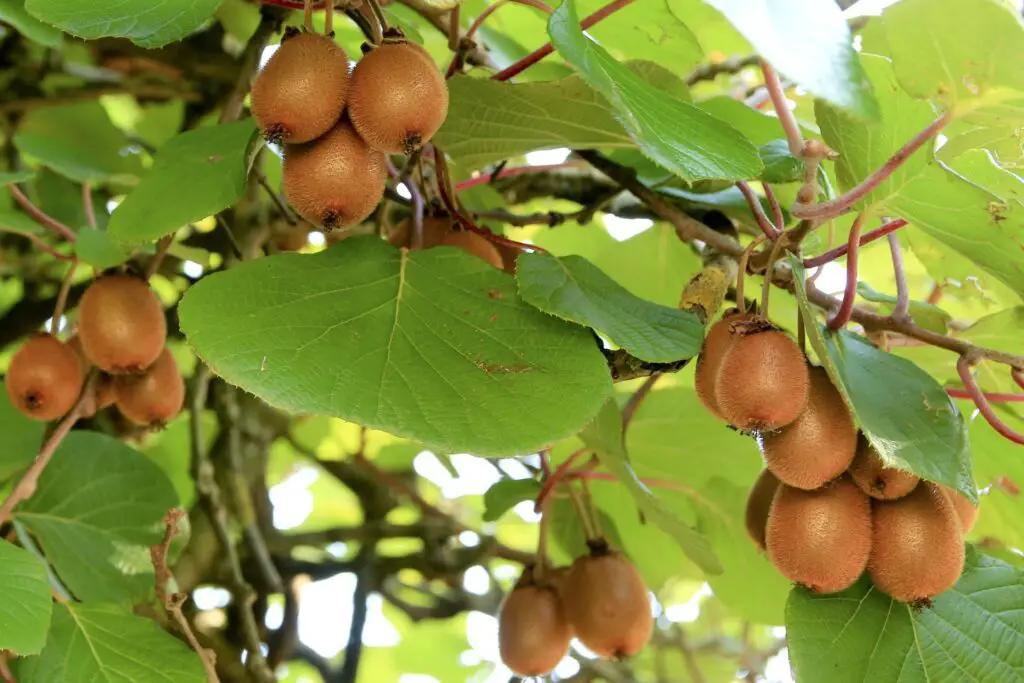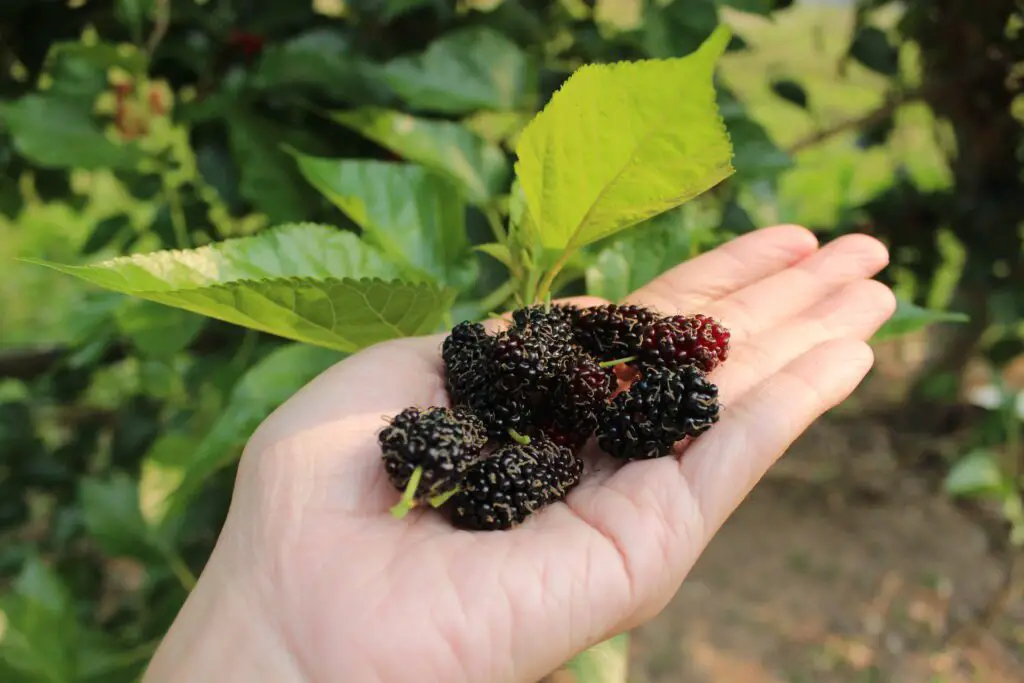Kiwi is considered one of the most delicious and nutritious fruits that can be grown in the home garden. Kiwi plants develop tons of kiwi fruit on vines. The only thing that will bother you in its growth and development is its long duration to reach maturity.
Kiwi plants take 7-8 years to start bearing fruit, so you should consider this a long-term investment. Everything you choose for this plant, from site selection to fertilization, should be accurate and optimal to make the most of this long-term commitment.
Quick Facts about the Kiwi plant:
- Kiwi vines start bearing fruit after 6-7 years of growth.
- It requires the most well-drained, sandy loam soil.
- Kiwi is a dioecious plant, having separate male and female plants
- One male plant is enough to fertilize up to 6 female vines.
- It requires a sturdy support structure to grow its vines.
- Kiwi plant does not grow true-to-type, which means that you will purchase and plant a grafted kiwi plant.
- It produces fruit on new growth; therefore needs to be pruned annually, in Jan or Feb.
How to Grow Kiwi Fruit in the Home Garden?
You will start by selecting the Kiwi plant variety, and then site selection, soil preparation, and planting will be done as the final step. Let’s start with the kiwi plant variety selection.
Kiwi Fruit Variety Selection:
There are three types of kiwi fruit that can be grown in a home garden:
- Common Kiwi (Actinidia deliciosa) – This is one of the most delicious kiwi fruits that is consumed fresh. You will find it in grocery stores. It is a brown, thick-skinned fruit having green pulp. It thrives best in the USDA zones 7-9 and requires about a month of cool temperatures (between -1 to 7 degrees Celsius).
- Golden Kiwi (Actinidia chinensis) – This Kiwi is also edible and sweeter than common Kiwi but less fuzzy and has yellow pulp. It thrives best in the regions where the temperature in winter goes as low as -12 to -1 degrees Celsius.
- Kiwi Berry (Actinidia arguta) – This Kiwi is named for two different kinds of kiwi fruit; Hardy Kiwi (Actinidia arguta) and Super Hardy Kiwi (Actinidia kolomikta). It is much smaller in size and has thinner and smooth skin.
How to plant Kiwi Fruit in a Home Garden?
It is planted in Jan or Feb when the fear of frost has passed. Being a vine plant, it needs plenty of space and severe pruning each year to get fruit from it.
You will need to plant at least one male and one female plant for them to bear fruit. You can plant more than one female depending on the space available, while one male plant will be enough to pollinate 5-6 females. Some self-fertile kiwi plants are available in the market, but they may be a bit costly.
Site Selection
Although it can be grown in the open in sub-tropical or warmer regions, kiwi fruits demand a warm, sheltered, sunny spot, especially against a south or west-facing wall.
- In the spring, young shoots are particularly susceptible to frost damage and need protection.
- Kiwi vines produce the best growth and fruit in sunny locations.
- Place your plants in a safe section of the garden to prevent wind damage.
- In colder climates, place the vines on the north side of the yard to reduce the possibility of freeze-thaw damage in the early spring, when plants are particularly vulnerable.
- Kiwi plants need well-drained soil since too much moisture might cause their roots to rot.
- Kiwi vines require strong support since they grow slowly.
- Build a tall, sturdy trellis structure that can support vines that can reach a width of 15 feet, a length of 20 feet, and a fruit production of up to 100 pounds.
Planting
- Planting both male and female kiwi plants will ensure a strong crop. The females produce the fruit.
- According to experts, one male plant should be present for every six female plants.
- Vines should be spaced 10 to 15 feet apart.
- If the roots are too lengthy upon planting, you might need to cut them.
- Plant vines just deep enough for the soil to surround the roots.
- At the time of planting, water thoroughly.
Care and Maintenance
- In the height of summer or other dry times, give the plants additional watering unless it has been raining.
- During the first year, avoid fertilizing. Afterward, fertilize in the spring with a well-balanced fertilizer or soybean meal.
- If not in bloom, prune the lateral growth two or three times during the growing season.
- Kiwis grow flowers and fruits on a 5-7-year-old plant
- Regularly remove water sprouts (which are robust shoots) that grow from older wood, as well as shoots from the trunk.
- When the plant is dormant, especially in the winter, it is the perfect time to prune female vines. On the other hand, the ideal time to prune male vines is when the plant has finished flowering or come out of the blossom period.
- Cold climates are unfavorable for kiwi plants, especially young ones; therefore, they need to be protected from frost.
Alternative Way To Grow Kiwi Plant In Home Garden
Other than seeding, Kiwi plants can also be grown by the “Propagation Method.” Softwood cutting will be better, and grafting and layering methods are preferable for propagating the kiwi fruit. However, if you are not an experienced gardener, you should buy prepared cuttings of male and female kiwi plants.
Spring season is the best time to plant the kiwi plant cuttings because they need warm weather and soil to grow properly.
In addition, spacing the male and female plants almost 3-4.5 meters will be the best to let the individual plant grow and spread sufficiently.
Harvesting Kiwi Fruit
The correct harvest time is very important for kiwi fruit. Hardy varieties have more chances of bearing fruit earlier; however, a long summer and autumn (September to October) also play important roles in fruit maturity.
The best way of harvesting the kiwi fruit is to pick the fruit before the first frost and place them indoors to ripen properly.
You will know that your Kiwi are ready to eat when a gentle squeeze reveals it to be a bit soft. It may take several weeks for your fruit to reach this stage.
How to Store Kiwi Fruit?
- Fresh kiwi fruit can be refrigerated for 5-6 weeks to be consumed as raw
- Freeze the whole kiwi fruit and store it in plastic bags
Pests and Diseases of Kiwi Plant
Being hardy, the kiwi plant is resistant to common fruit pests. However, there are certain environmental factors, such as nutritional imbalance and waterlogged conditions, that may lead to the attack of the following diseases such as:
- Root rot
- Phytophthora crown rot
FAQs:
Can I use kiwi fruit in gelatin recipes?
No. the reason is that the kiwi fruit contains a protein-digesting enzyme known as “Actinidain” and cannot be used in recipes with gelatin products. The enzyme will start digesting the proteins in the dishes and will not let the liquid recipe solidify.
Can I grow kiwi plants in pots?
Yes. Kiwi plant grows into long vines, which means that they require space and support to grow sufficiently. You can grow kiwis in pots or containers of larger sizes but always remember to stack them appropriately and space them sufficiently.
What is the best fertilizer for a young kiwi plant?
The best fertilizer is compost or other organic fertilizers such as vermicompost, leaf litter, etc. However, in the month of fruiting, the plants may need a quick nitrogen source which is provided in the form of ammonium nitrate or urea (10-10-10).


